Last year, I presented a modern, connected security system: theAjax StarterKitalarm. This year, ProtectHome, our partner specialized in home security, gave me the opportunity to test the Ajax Hub 2 version: it has everything that made last year's version such a success, but with a few significant additions, such as support for motion detectors with photo capture. This new test is also an opportunity to discover other very interesting sensors, as well as some home automation possibilities.
Ajax Systems is a relatively young company in the alarm field, having been founded in 2011. But this Ukrainian company quickly specialized in the development and manufacture of security systems, wireless motion detectors and wireless window and door opening sensors. As a result, it quickly became a reference in the field. It's simple: when someone asks me for a high-performance, connected alarm, I immediately think of Ajax. And the functions we're going to discover today will only confirm my excellent impression of this alarm system.
For this test, I received an Ajax Hub 2 alarm, along with a few additional accessories to give me an idea of the possibilities. Of course, all the peripherals seen last year (remote control, opening detector, motion detector, etc.) are perfectly compatible with this new control unit.
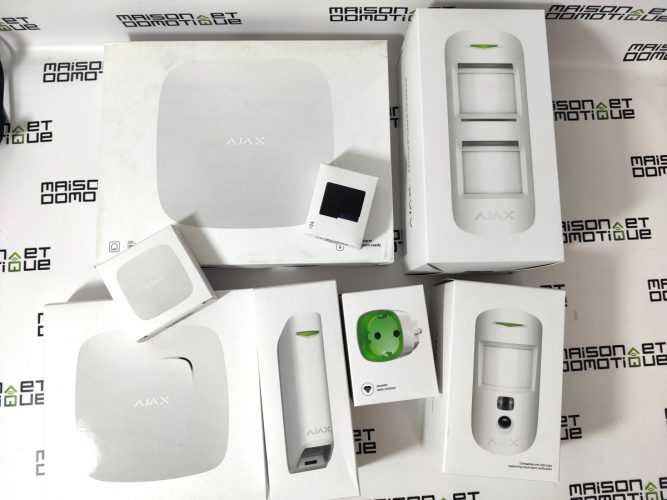
Unpacking the Ajax Hub 2 alarm unit
The Ajax Hub 2 control unit
The Ajax Hub 2 alarm control unit is delivered with its power cord, an ethernet cable, and a short operating manual. We've also included some stickers indicating that the property is protected by an Ajax alarm, which is always a deterrent.
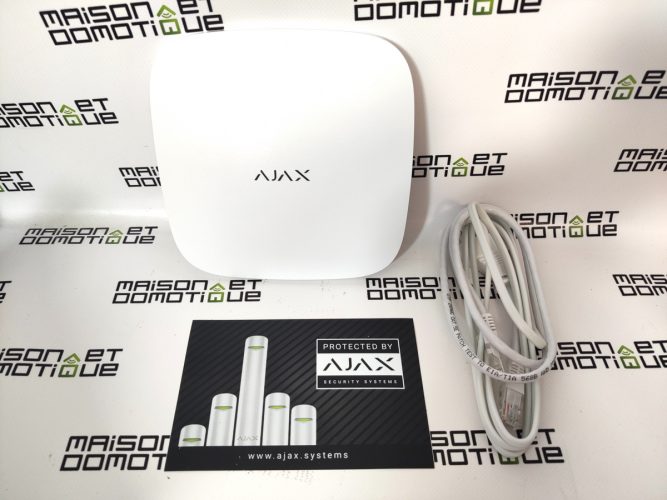
This is the brain of the Ajax security system. At first glance, it's identical to the first version we saw. From the outside, it looks like a wireless router: the body is square with chamfered edges. A luminous Ajax logo on the front panel provides information on the status of the Ajax Hub's connection to the Ajax Systems infrastructure: red (there is no connection), green (there is a connection only via one channel, Ethernet or GSM), white (both channels are used for the connection).

On the rear side, a connector is concealed for connecting the set's power cable, and an RJ45 connector for connecting the Ethernet cable.
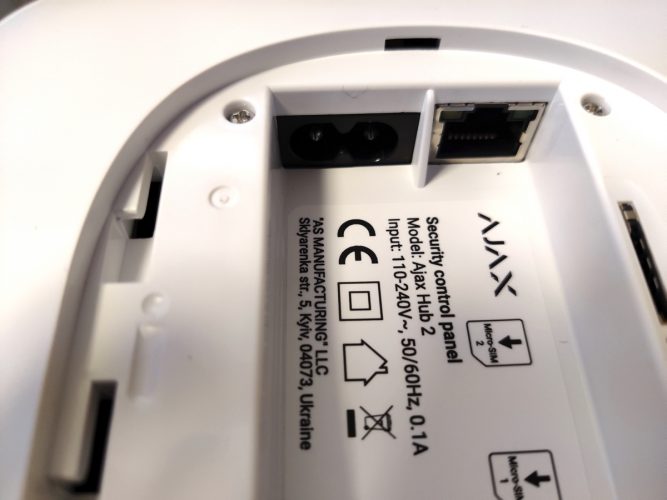
One difference with the previous Hub is the possibility here of using not one, but two Sim cards! The idea, of course, is to use two different operators. So if one doesn't respond, you can switch to the next. This gives us double protection: if the Internet connection fails (via the Ethernet cable), we can still use the 1st Sim, and if it doesn't respond, the second Sim. You can't get much more secure than that!
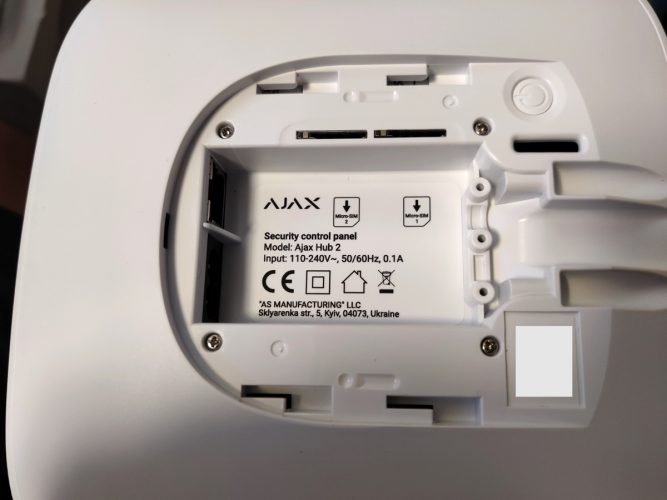
All these elements are closed by a cover, which includes openings for wall-mounting the control unit. The cover itself is fitted with a tamper-proof device, based inside the control unit, which locks the contact in the closed position. This system protects against unauthorized opening.

The quality of the materials used is excellent: the cover is perfectly matched to the connector, and there is no gap in the closed position. Closing the lid fastener is accompanied by an audible click and tactile sensations, allowing you to understand without error that you've put it in the right position.
The designers wanted a system that was quick and easy to install. So they opted for wireless communication between all peripherals. But we're talking about a security system here, so communication must be reliable and protected. To achieve this, the Ajax alarm uses the Jeweller protocol, created by the company itself, as existing systems have too many weak points according to the designer. Jeweller is a communication system involving coding, synchronization and a power control algorithm for power optimization:
- The data exchanged between the devices and the control unit is packaged in encrypted packets. These bits of information are transferred in milliseconds;
- The data packets are encrypted using their own jCrypt algorithm with a floating key, which was also developed from scratch.
- The hub always knows which device it's exchanging information with, even in the event of strong radio interference. In the event of a mismatch or poor connection, the control unit initiates the sensor authentication process for a second synchronization with the system.
- Each device knows where and when it entered the system, and sends a signal to the control unit at 12-second intervals;
- The connection radio channel is protected by multi-level filtering. If the control unit detects a dubious signal, the in-depth examination process is initiated. If a single discrepancy is detected, the system will stop responding to signals from the suspect source.
- The control unit is able to switch from one frequency to another to avoid signal loss. It also determines which detectors have been influenced by the source of the countermeasures.
- The frequency range in which the control unit maintains radio communication with the devices is 868 to 868.6 Hz. The maximum radius of interaction with Ajax devices is 2 km in an unobstructed environment. For connection with each device, the control unit uses its own frequency. Maximum radio signal power is 25 mW. Up to 100 devices can be connected to the system. That's enough to safely protect a private home of any size.
What's more, the control unit is equipped with a 2Ah Li-lon battery, providing up to 15 hours of autonomy in the event of a power failure. System administration and parameter changes are made via the iOS/Android app and the web app.
Other differences with the first Hub include support for a greater number of scenarios (32 instead of 5) and more cameras (25 instead of 10). The Hub 2 also supports up to 5 repeaters, but this will be useful for very, very large properties, as the range of the various peripherals is already impressive without any repeaters.

Let's move on to the peripherals. For the sake of completeness, I'll also take a quick look at the peripherals I saw last year.
MotionProtect motion detector
The MotionProtect detects movement in the home. After opening the MotionProtect box, you'll find the detector itself, the installation kit and instructions.
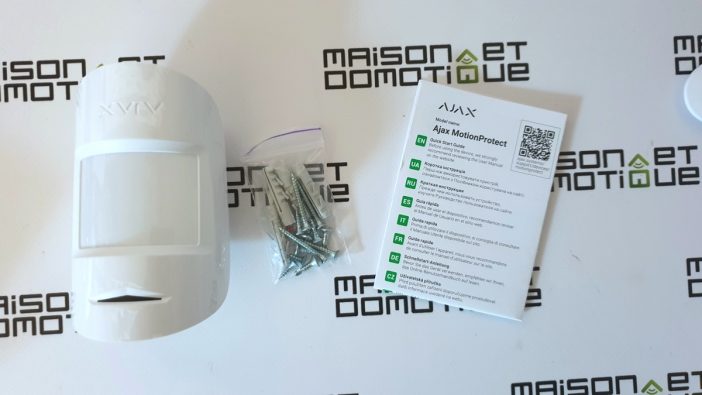
The detector is made of thick, polished white plastic. A lens is located in the center of the front panel. A light-emitting diode in the upper part will light up when motion is detected in security mode, or will also serve to indicate the quality of radio contact with the main network when testing signal level. The engraved Ajax Systems logo is located at the bottom, but remains discreet.
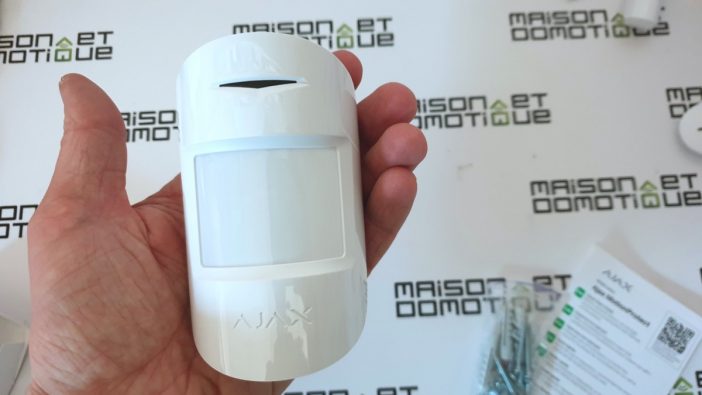
MotionProtect is fitted with a SmartBracket for wall mounting. This facilitates mounting, as the detector does not need to be dismantled to be attached to the wall. In addition, the SmartBracket is fitted with a tamper-proof device, which protects the MotionProtect from unauthorized opening, in the same way as the control unit.
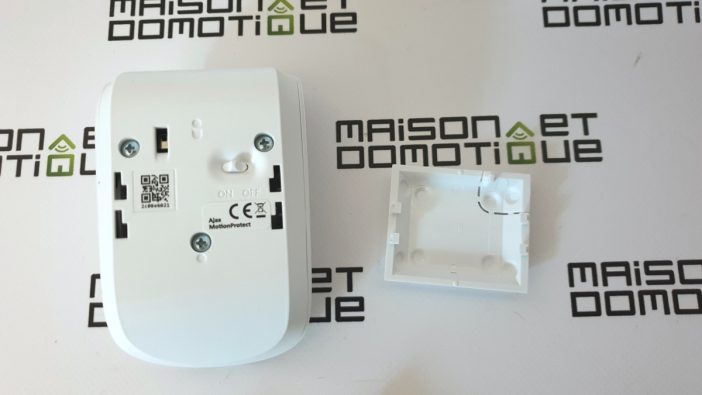
The detector is capable of detecting movement at a distance of up to 12 meters (viewing angle 88.5° horizontally, 80° vertically). An infrared sensor is located behind the white lens. As is often the case, the detector should not be installed in front of a window, to avoid sunlight falling on the sensor lens, or in front of objects whose temperature changes rapidly (electric and gas heaters, etc.). It should be noted that the software controlling the detector is “intelligent” enough to ignore animals weighing up to 20 kg and having a height of 50 cm.
The detector registers the change in the “temperature image”, but the closer the ambient temperature is to the temperature of the human body, the lower the contrast of the “image”. The temperature compensation algorithm (detector sensitivity adjustment), which enables optimum sensitivity adjustment so that no individual is missed, was developed by Ajax Systems specifically for this purpose.
MotionProtect uses its own first-step motion detection algorithm, FirstStepDetection. It is based on the fact that the detector's processor traces the signal on the output of the RIP sensor in real time mode (passive infrared sensor) and reacts to changes in the output signal, filtering out false operations.
The detector has three sensitivity levels:
- High level: the detector does not react to any object smaller than a hamster.
- Medium level: the detector does not react to any object such as a small dog or cat.
- Low level: the detector does not react to any object the size of an average dog weighing up to 20 kg.
When the security system is in “security” mode, the detector sends an alarm signal if movement has been detected, but no more than once in 5 seconds, by synchronously lighting up the LED. When the security system is in passive “inactivity” mode, the detector does not react to movement more than once in 3 minutes without lighting up the LED. In the detector parameters, you can deactivate the motion detection mode if the control unit is not in security mode. This saves battery power. According to the manufacturer, battery life is an impressive 7 years on a CR123A battery! The battery can then be easily replaced by the user.
MotionCam photo motion detector
The MotionCam is a motion detector quite similar to the previous one, but also incorporating a camera for taking photos. The switch to Hub 2 is justified by the use of this sensor, which is not supported by the first version.
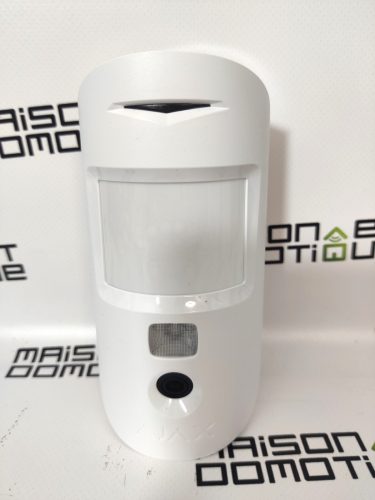
The MotionProtect features the same characteristics: 12m of detection, over a 90° angle. Same SmartBracket mounting system:
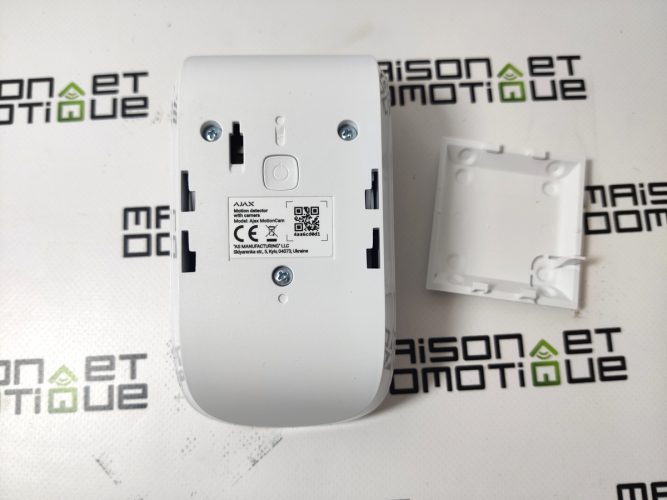
The difference is this lens, capable of taking burst photos at the slightest detection, sent in less than 9s (1 to 5 photos in 320x240px resolution, or 1 to 3 photos in 640x480px resolution, to get a glimpse of the movement in progress).
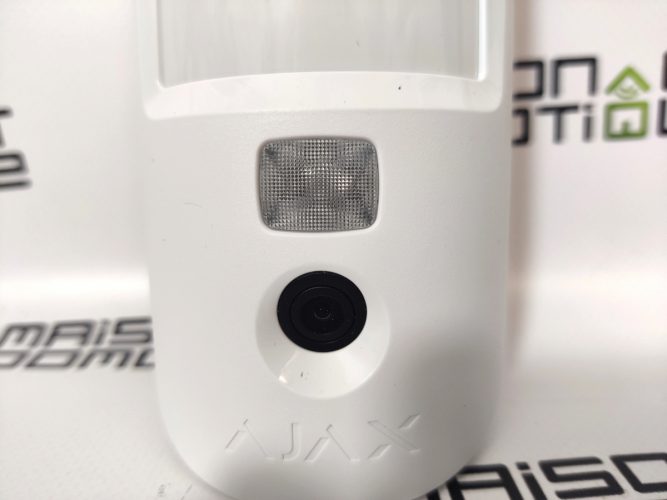
Inevitably, autonomy suffers, but it's still rated for 4 years thanks to its CR123A battery! Please note, this is not a camera you can connect to at any time to check what's going on: the MotionCam only takes photos when it detects suspicious movement.
MotionProtect OutDoor outdoor motion detector
Of course, for complete motion detection, there's also an outdoor model, the MotionProtect Outdoor.
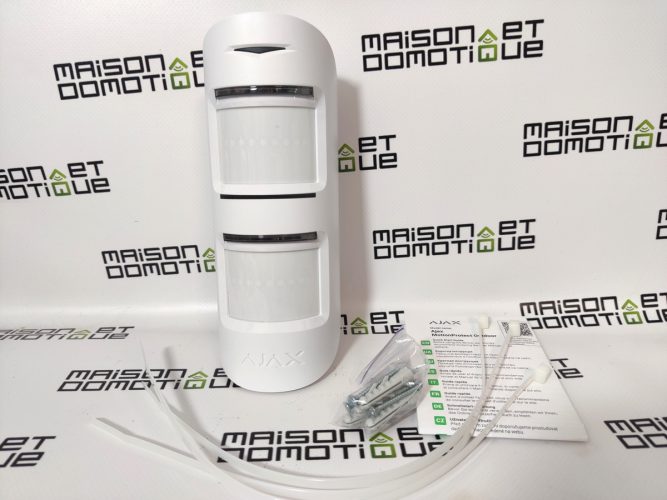
This model features a double detection cell for optimized outdoor operation. Supplied with fixing screws, but also cable clamps for mounting on a pole or mast, for example.

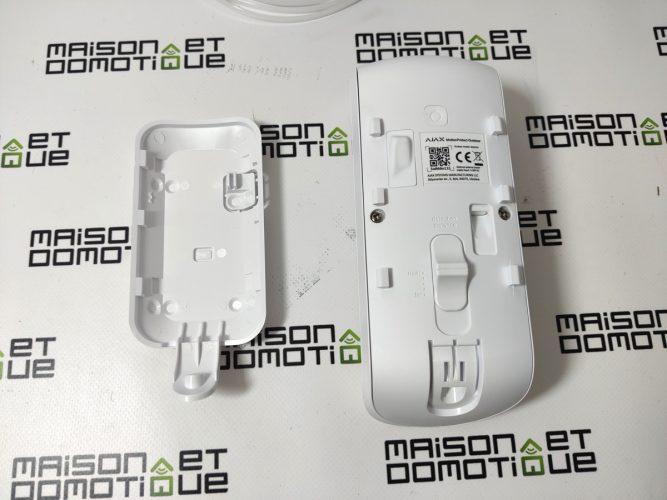
Positioned at a height of 1m, MotionProtect Outdoor is capable of detecting the slightest human movement between 3 and 15m, at an angle of 80°, and ignores animals up to 80cm away. Sensitivity can be adjusted via a slider on the back:
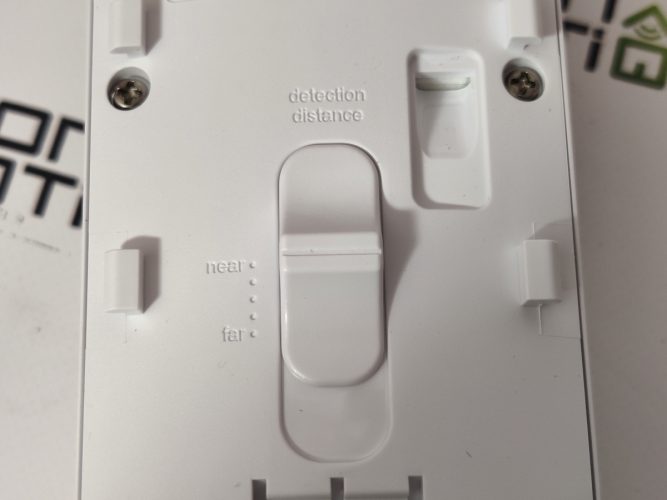
As for autonomy, the Outdoor version uses 2 CR123A batteries.
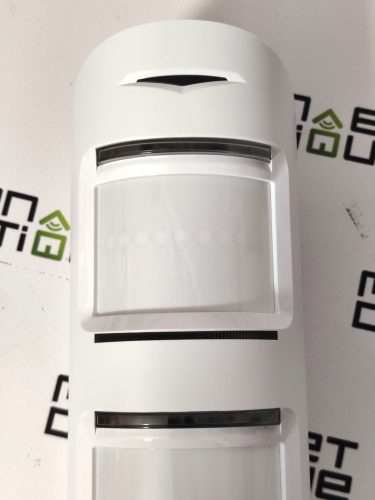
MotionProtect Curtain motion detector
A final motion detector, the MotionProtect Curtain.
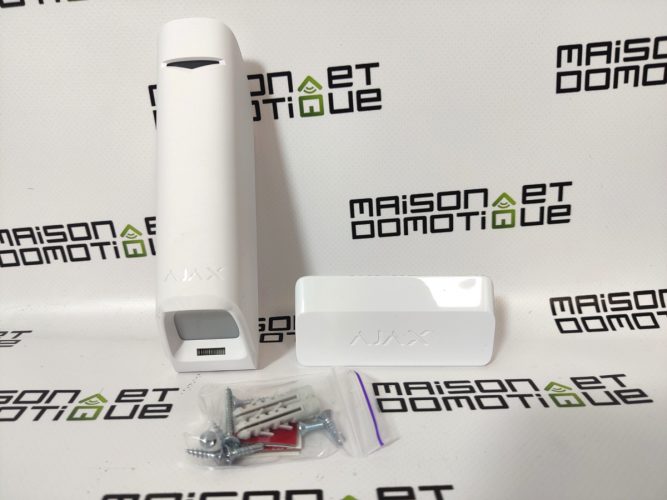
This one will be for more precise use, since it uses a narrow horizontal beam (6° horizontal angle, 90° vertical), or curtain type (hence its name). It's particularly well-suited to monitoring doors, windows or garage doors, like this one:
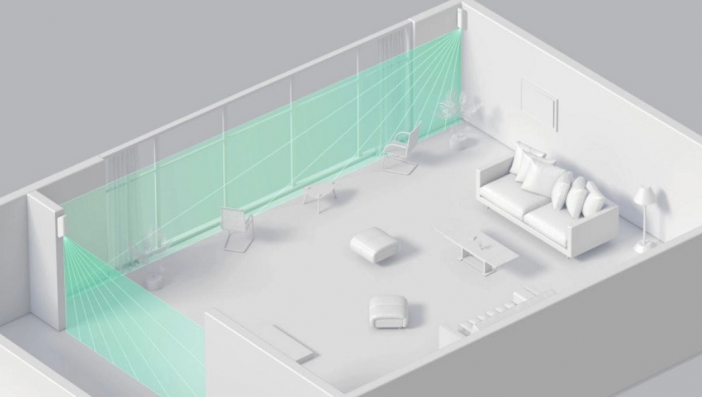
Its operation is very practical, since it's possible to be present in the room without triggering the alarm. The alarm will only be triggered if someone enters through a door or window. With a single sensor, you can protect several openings, which can also be more economical.
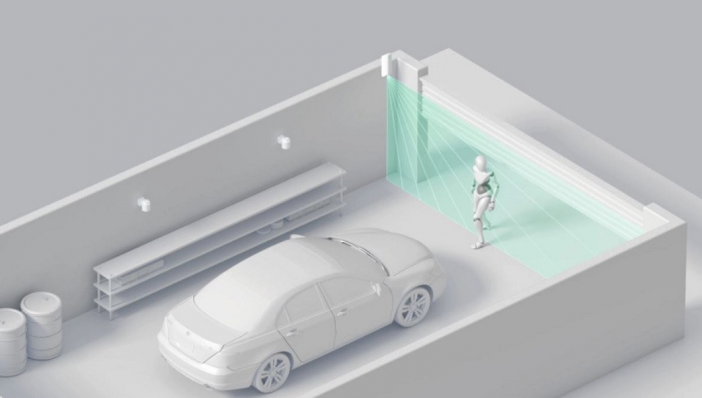
For optimum operation, however, it needs to be correctly positioned, ideally at a height of 2.4m, and in a “frame” (between wall and ceiling).
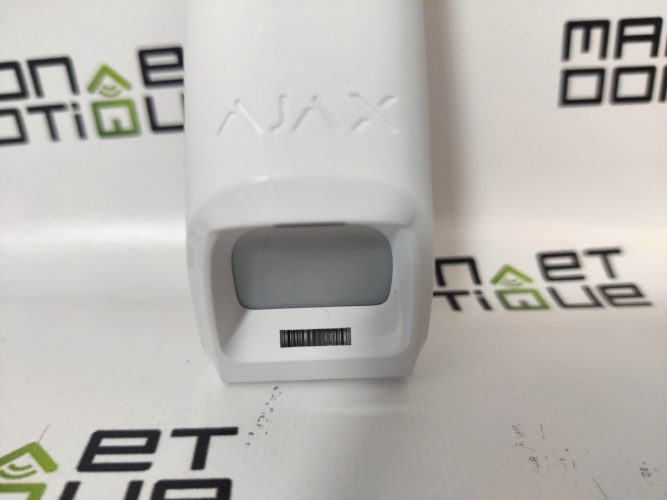
Also powered by a CR123A battery, this sensor is rated for 3 years' autonomy.
DoorProtect door/window opening sensor
The name of this sensor speaks for itself. DoorProtect's main function is to signal unauthorized opening of doors and windows. As with the other peripherals, the detector itself is made of smooth, white plastic.

DoorProtect consists of three parts: an active block with all the electronics and two magnets: a large one and a smaller one. The large magnet is similar in shape to the active block. A green light-emitting diode is located in the upper part of the active block.
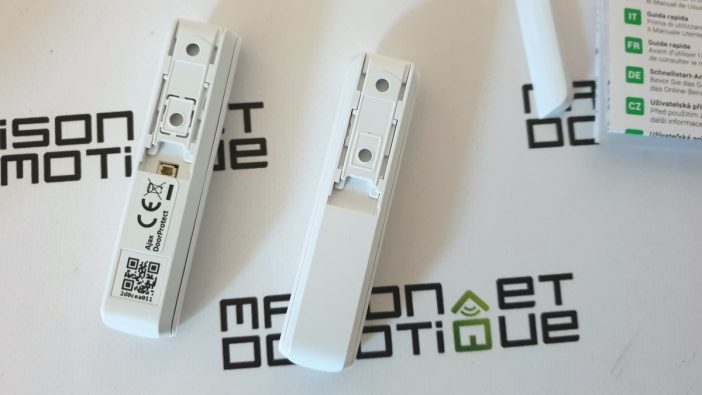
All three elements feature SmartBracket mounting panels for wall mounting. The SmartBracket can be attached using double-sided adhesive tape or screws. The SmartBracket mounting panel on the active block is also tamper-proof.
The minimum distance the magnet must travel from the detector to send the alarm to the control unit is 2 cm when using a large magnet, and 1 cm when using DoorProtect with a smaller magnet. A connector on the rear panel of the detector's main unit is also available, for connecting an additional wired detector.
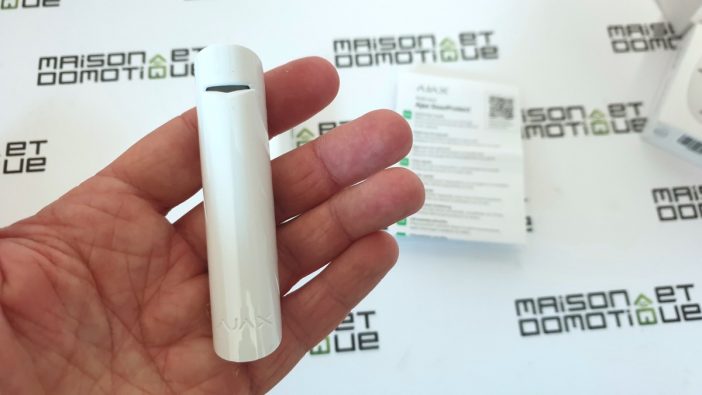
According to the manufacturer, DoorProtect can operate for up to 7 years on a CR123A battery. If the battery is completely discharged, it can be easily replaced by the user.
SpaceControl key ring
The SpaceControl looks like a car alarm keyring. It is made of white or black plastic, which is pleasant to the touch.
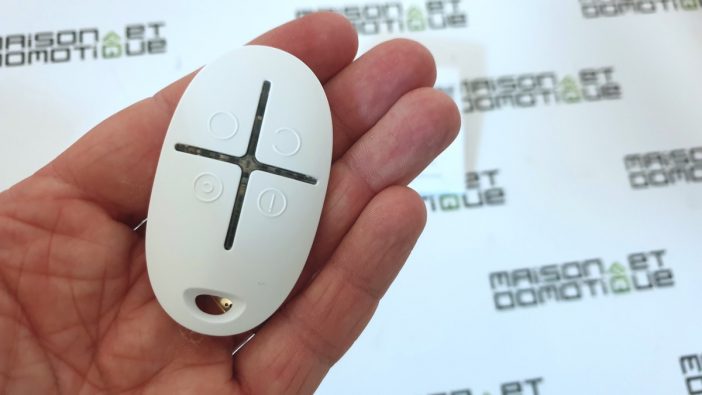
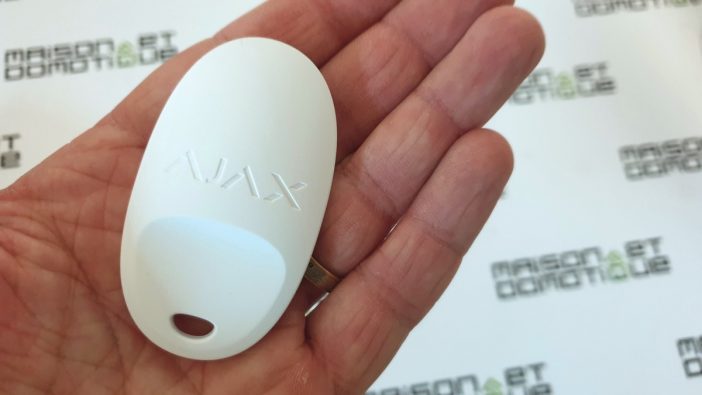
It allows you to control the Ajax alarm control unit: the security system can be switched to total security, partial security and you can send an alarm signal to a security control panel. If your Ajax Hub is not connected to the control panel, then pressing this button will cause the HomeSiren and StreetSiren sirens to operate (if connected) and it will send an alarm signal to users' mobile devices, which control or use the Ajax Hub.
The company says SpaceControl can operate for 5 years on the СR2032 battery.
The FireProtect fire detector
The Ajax alarm system doesn't stop at detecting movement and openings. It includes other detectors, such as this fire detector, capable of detecting both smoke and rapidly rising temperatures. In fact, some materials produce very little smoke, but heat up very quickly. For a complete fire detection system, it's a good idea to have a detector capable of tracking both indicators.

The design is uncluttered, and looks very similar to the control unit, except for a small LED in the corner indicating its operation. Dimensions are classic, with 13cm sides and 3cm thickness. Very similar to the Nest model, for example:
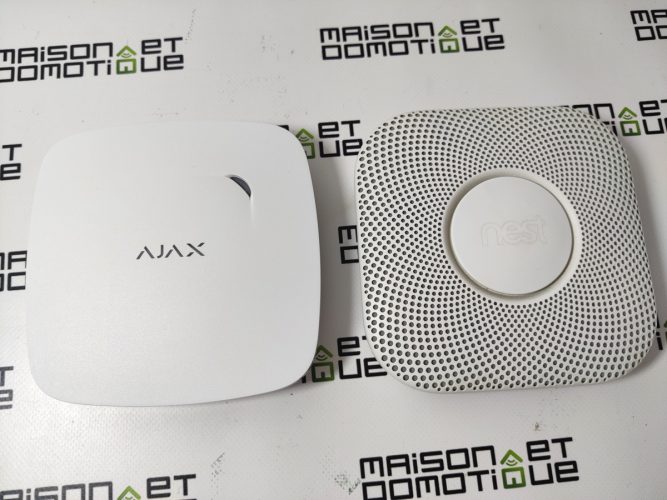
Smoke detection uses a photoelectric sensor camera: when smoke enters the system, it passes through the sensor's infrared light. Distortion of the infrared beam triggers the alarm.
In the case of temperature rise, the alarm is triggered if the temperature rises by 30° in 30 minutes, or exceeds 60°.
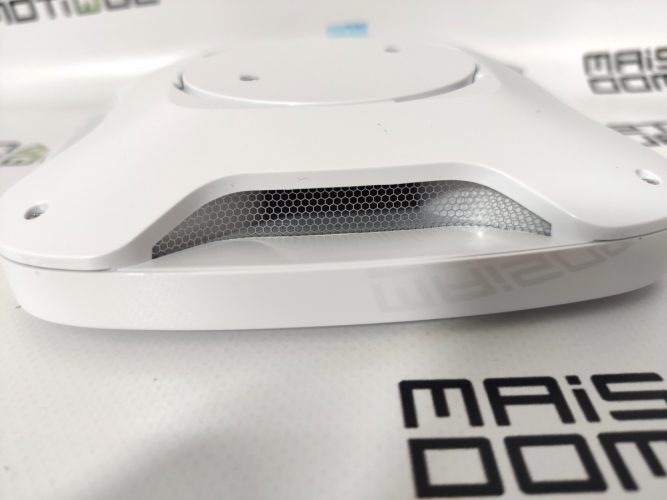
Like all fire detectors, it's ideal for ceiling mounting. All you have to do is attach the bracket, then clip the detector itself onto it:
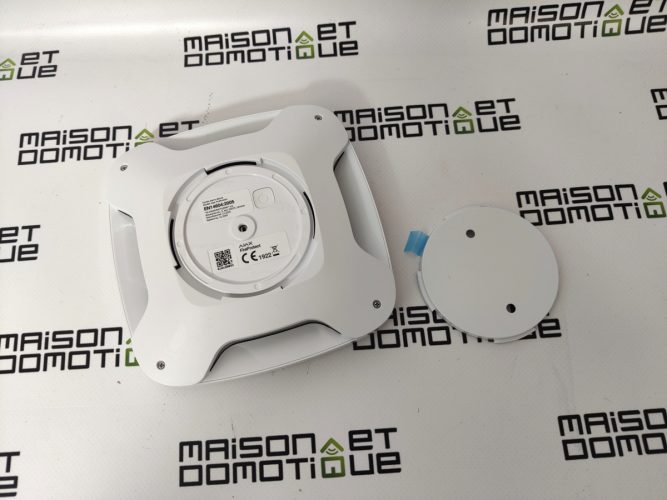
This fire detector features its own 85dB siren in the event of an alarm. Conveniently, the various sensors can be synchronized with each other: if a fire is detected in the cellar, for example, the other detectors in the house can also be triggered to alert you to the problem (as you may not hear the sensor ringing in the cellar, for example).
The sensor can also inform the user when its batteries need replacing and when its smoke chamber needs dusting!
This detector has a 4-year autonomy thanks to its two CR123A batteries.
A FireProtect Plus version is also available, featuring carbon monoxide detection.
LeakProtect flood detector
In addition to fire, the other risk in the home is flooding. A burst pipe, a leaking washing machine, etc. are just some of the reasons why water damage can occur in the home. So a flood sensor is always useful, especially when linked to a connected alarm system that can warn you wherever you are.
The Ajax flood sensor is a very compact little device, measuring just 5.6cm on a side and 1.4cm thick, so it fits neatly under a washing machine:
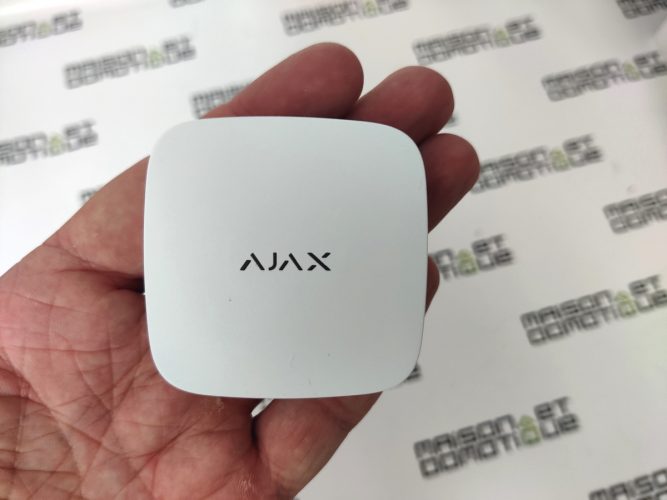
For detection, it has 4 groups of 2 sensors on the underside: as soon as one of the groups detects water, the alarm is given.
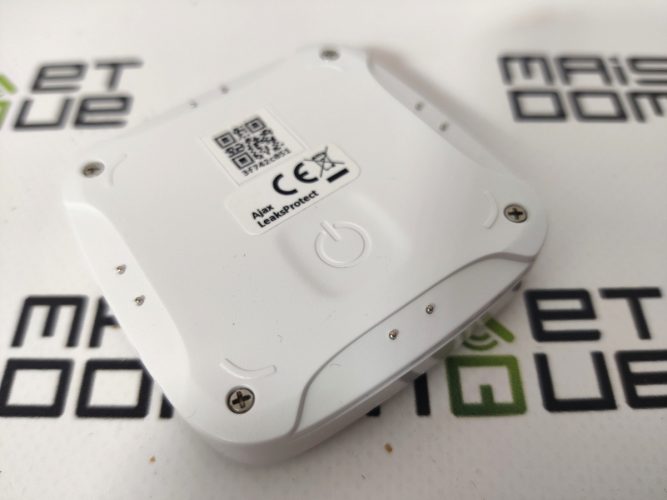
Setting up this LeaksProtect is extremely simple, since all you have to do is place it on the floor, where there's a risk of flooding (washing machine, dishwasher, bathtub, etc.).
Here, no CR123A, just two AAA batteries, which should give an autonomy of around 5 years.
Home automation actuators: connected sockets and relays
Ajax also offers some useful home automation peripherals, namely a connected socket and a relay.
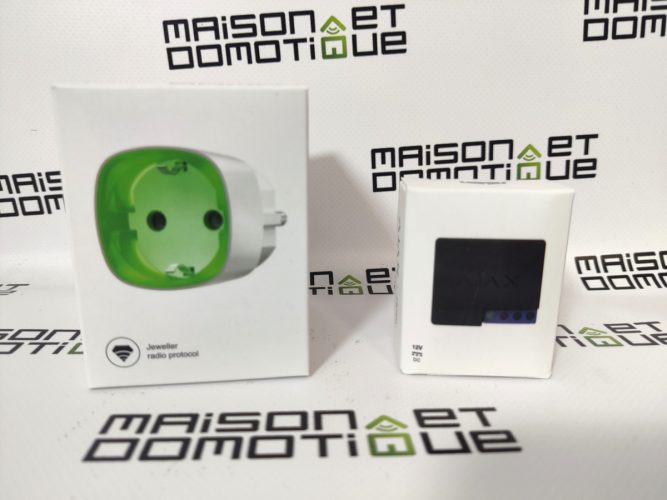
The Ajax Socket is a small plug capable of supporting up to 2500w of load. It can be used to control appliances remotely, as well as to monitor power consumption. It can also be activated via scenarios, for example, to automatically switch off certain appliances when you leave and activate the alarm, thus saving energy.
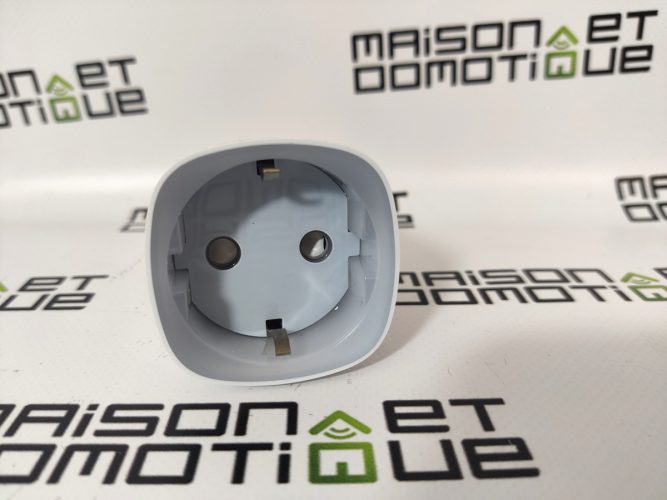
As you can see, it's very compact, and several sockets can be placed side by side without any problem, on a power strip for example. A colored LED light indicates current power consumption= yellow up to 550w, orange up to 1250w, red up to 2000w, and red up to 2500w.

On the other hand, its price of 86€ is very high for a connected plug of this type :/ It does, however, protect appliances against overloading and short circuits. If the temperature exceeds 85°, the plug also switches itself off. And above all, an excellent range compared with the usual home automation protocols such as Zwave and ZigBee, since this one is given for 1300m!
Finally, the Ajax Relay is a micro-module that acts as a… relay. It can be used to control equipment such as blinds, gates, garage doors, electric strikes and so on.
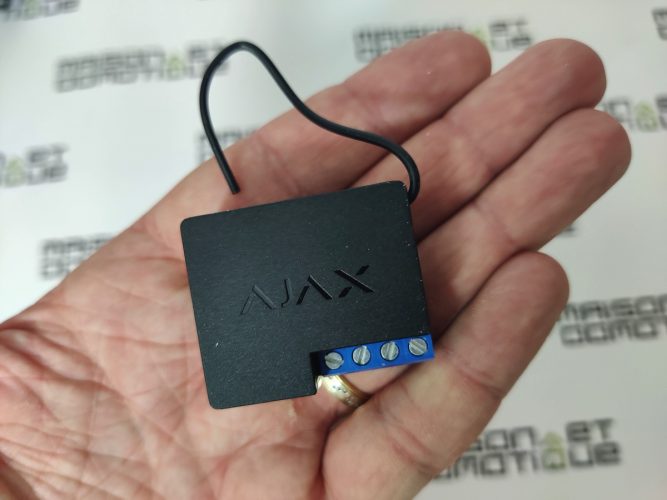
Simply connect it to a power supply ranging from 7 to 24V. It can be placed in a junction box, or even in the electrical panel, to control a complete circuit if desired (note that installation here is more technical, and may require the intervention of a professional).

There are many conceivable uses for this type of relay: controlling your gate or garage door, automatically closing your shutters when you activate your alarm, cutting off an entire power line when you leave, etc.
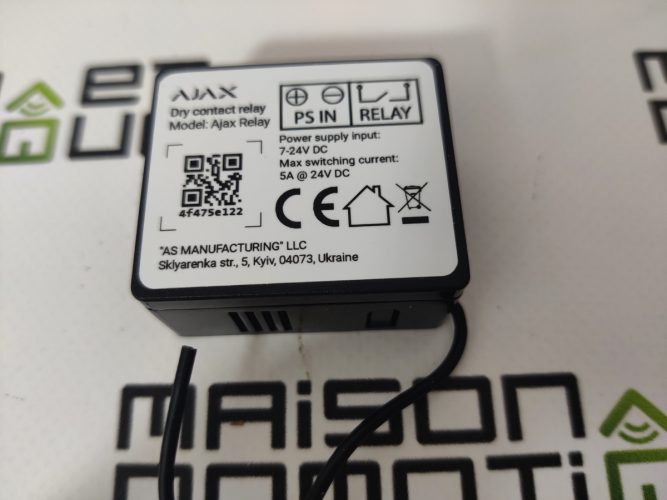
The possibilities are endless, and using scenarios, you can automate many things.
Other Ajax sensors available
These are just the devices I was able to test. That's a very good selection. But there are many other peripherals available, such as..:
- CombiProtect, a combined motion and glass breakage detector,
- GlassProtect, a glass breakage detector,
- Keypad: a wall-mounted keyboard,
- panic button,
- indoor/outdoor sirens
- 220v micro module
- various transmitters to make third-party devices compatible with the Ajax alarm (like the Optex perimeter detector we saw, for example).
And other peripherals are planned in the near future, such as the MotionCam or the Curtain for outdoor use. The eco-system is therefore extremely complete!
Let's move on to the installation and configuration of the system…
Ajax Hub 2 alarm configuration
The Ajax security system is a connected system, so it can be configured and controlled via a mobile app, available on Android and iOS.

To use these applications, you need to create an account in Ajax Security Systems and a login. When registering, you'll need to enter your e-mail address and telephone number. Registration codes will be sent to them, which you'll then need to enter into the app to validate. In future, the e-mail address will be used as the identifier when connecting to the applications, and Ajax alarm notifications/messages concerning sensor activation, security mode activation/deactivation, etc. will be sent to the telephone number indicated.
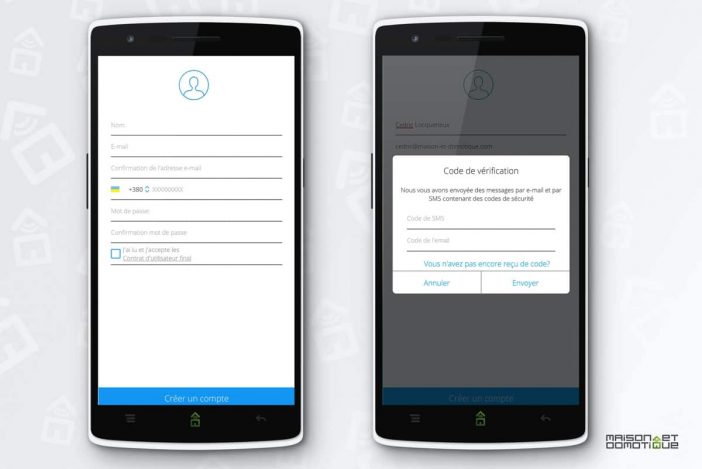
After entering your login and password in the application, you will be redirected to the Devices tab. If you have no devices installed, you will be prompted to connect the control unit.
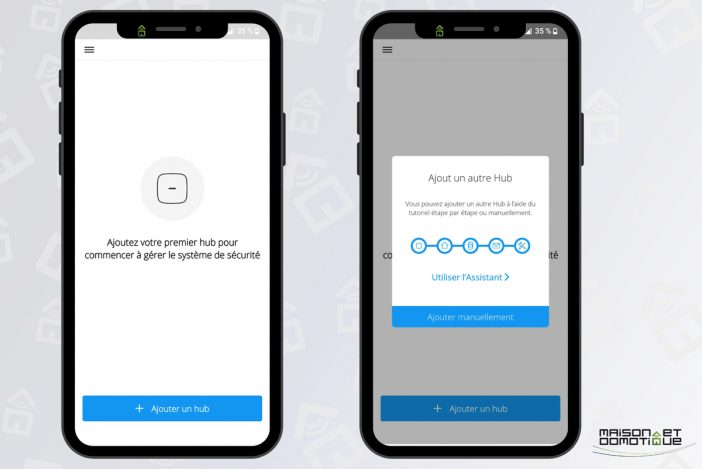
Adding a device is very simple, as all you have to do is scan the QRcode on the control unit using your smartphone's camera. The same principle applies to all devices to be added. Just give it a name, and that's it!
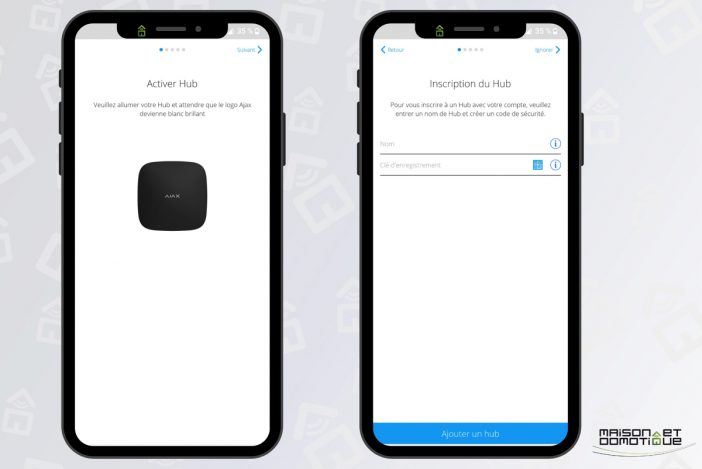
For the Ajax alarm control unit, you can configure the connection modes, since the control unit can connect via ethernet to the home's internet router, or via GSM by adding a Sim card (not supplied).
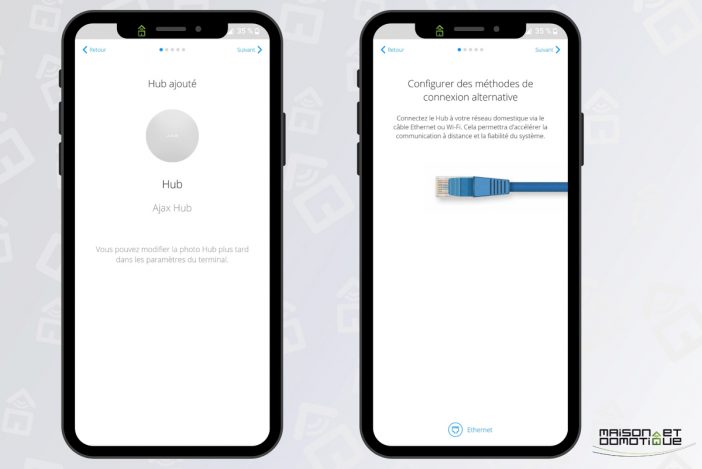
You can then assign the device to a room.
All peripheral additions are made in the same way: you scan the peripheral's QR Code, then switch it on so that it's detected by the Hub. It's really quick and easy!
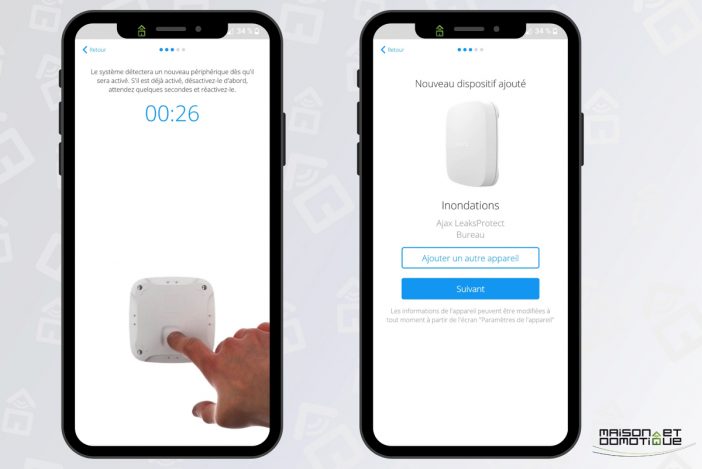
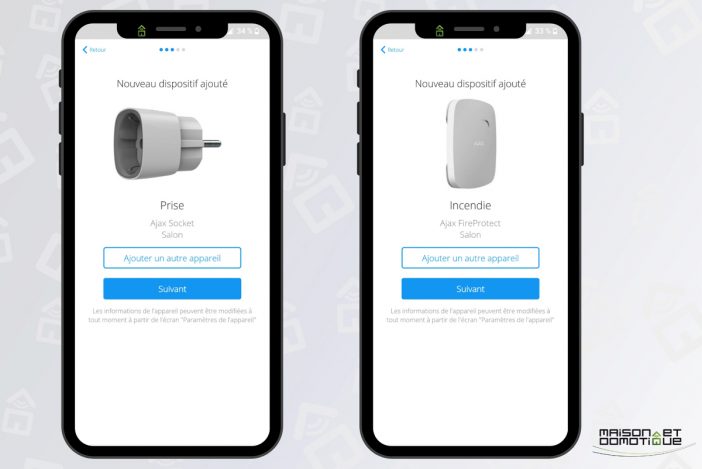
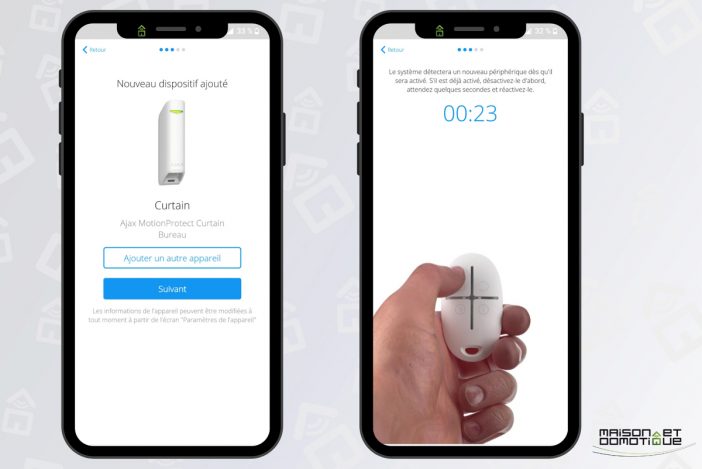
At the end of configuration, you can add users (up to 50!)

And configure very precisely the notifications per user:
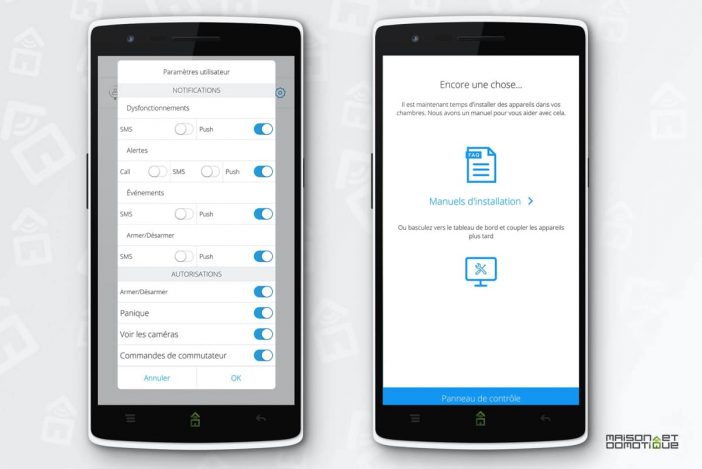
It's also possible to define a 4-digit code for faster access to the mobile application (fingerprint recognition is also supported in the application settings).
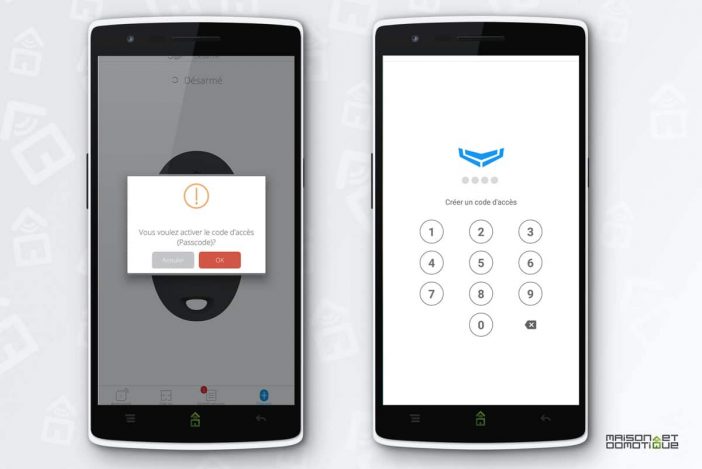
Last but not least, the addition of the SpaceControl remote control. There's no QRCode to flash here: simply press the arm and panic buttons simultaneously, and the remote will be detected by the control unit. You can then assign the remote control to a specific user.
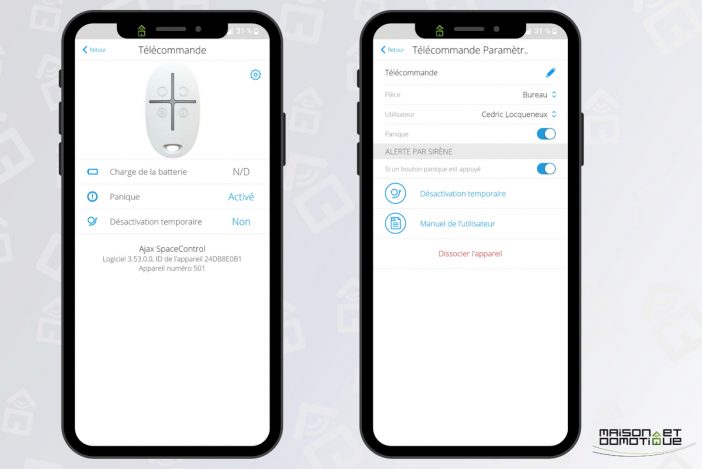
The 4th tab of the application, for remote control, uses the same design as the remote control, to manage alarm status. This is something you'll find on many connected alarm models, and ensures that the user is not disturbed between his physical remote control and his smartphone.
Communication with the hub is not direct, but takes place here via the Ajax Systems infrastructure. The advantage of this type of communication is that you can control your control unit from anywhere you have an Internet connection. Conveniently, after clicking the alarm button in the app, the alarm signal from the location with GPS coordinates from your smartphone will be sent to the apps of registered users on your Ajax Hub. Something the physical remote control won't be able to do.
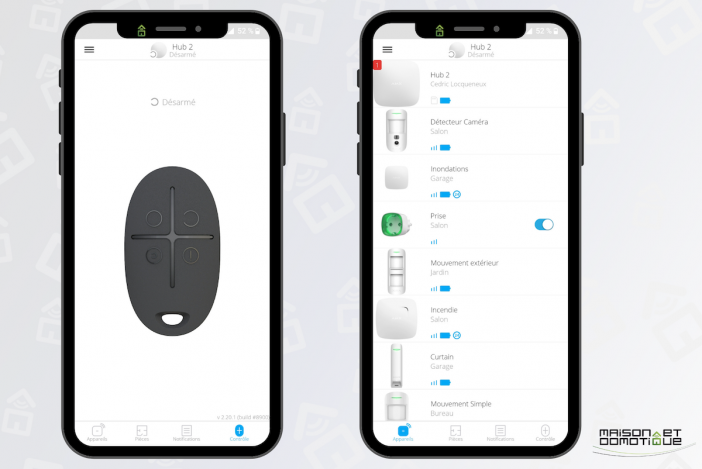
The app allows you to go much further, since once the hardware has been added, you'll be able to see the control unit and the list of connected devices. You can access additional device settings and detailed status by clicking on each device or hub.
For example, by clicking on the Ajax hub icon in the Device tab, you'll be redirected to the screen containing more detailed information on the hub's status:
- Connection status. This displays the connection status of the hub. Online” status is displayed if at least one connection channel (GSM or Ethernet) is active and the connection to the Ajax Systems infrastructure is established.
- Average noise (dBm). As the hub is equipped with two antennas for connection to the detectors, the noise level of each of them will be displayed here. The higher the number, the lower the level. If the noise level rises above -40 dBm, the control unit will inform you (in most cases, an increase in noise to this level is evidence of a jamming attempt).

If the device is affected by a critical event or something requiring the administrator's attention, information is displayed in red.
There's a lot of information here: battery status, the device name, which is given by the user when registering, the room in which the device is registered, the connection quality indicator, and so on. In the case of the hub, the indicator shows the type of connection to the cellular network, and in the case of the detector, the quality of the connection to the Ajax hub.



Peripherals can be configured in different ways. There are four modes in the application:
- Entry delay: an entry delay can be set before the alert is triggered.
- Delay on exit: a delay can be set for the exit.
- Always active. A device that is always under surveillance, regardless of the hub's status. If this type is selected, the device will operate in “security” mode 24 hours a day, 7 days a week.
- Arm in night mode: the detector will be used for partial mode (or night mode).

To personalize the display, you can also assign an image to the room. There's also the room temperature, read by the temperature sensor integrated into certain peripherals.
The Notifications tab lets you follow the history of notifications concerning events that have been declared by detectors or the control unit. The Ajax hub can store up to 500 messages in its log.

With a little digging into the options, many things can be achieved. For example, use Geofencing (your smartphone's position) to automatically remind you to activate your alarm when you leave, or remember to deactivate it when you return.
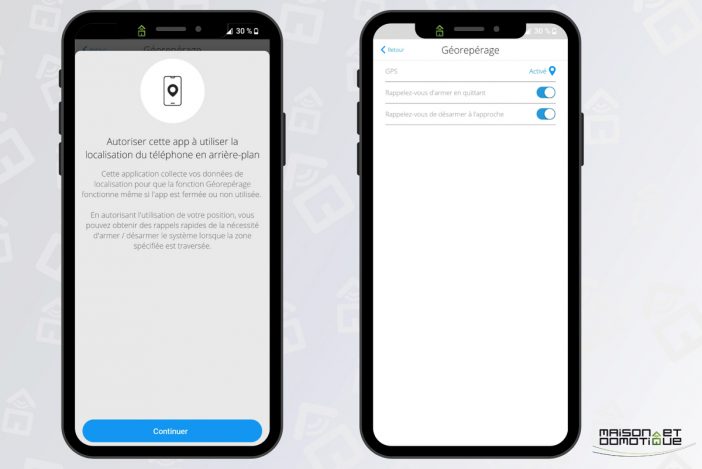
A calendar also lets you automatically activate or deactivate the alarm according to the days and times you want. An option I really like is to automatically activate the alarm at a certain time in the evening, so that you don't forget to activate it (the only time I've ever forgotten to activate an alarm, of course there was an intruder attempt during the night…).
The system also manages up to 9 groups, which is handy for creating zones: for example, you can activate the alarm for the ground floor, but not for the first floor, where you can move around freely at night.
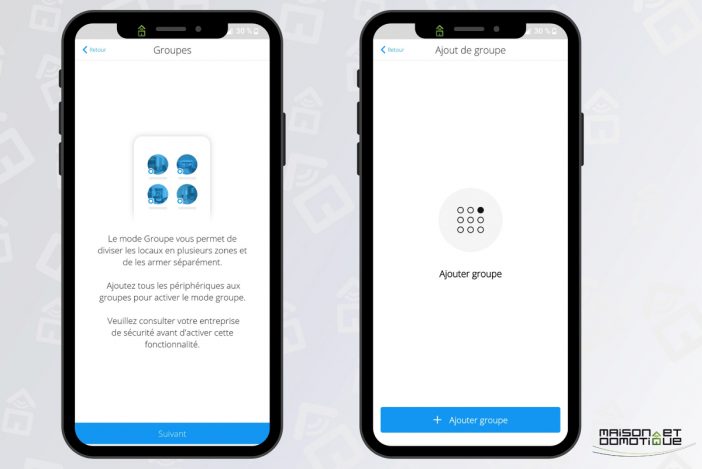
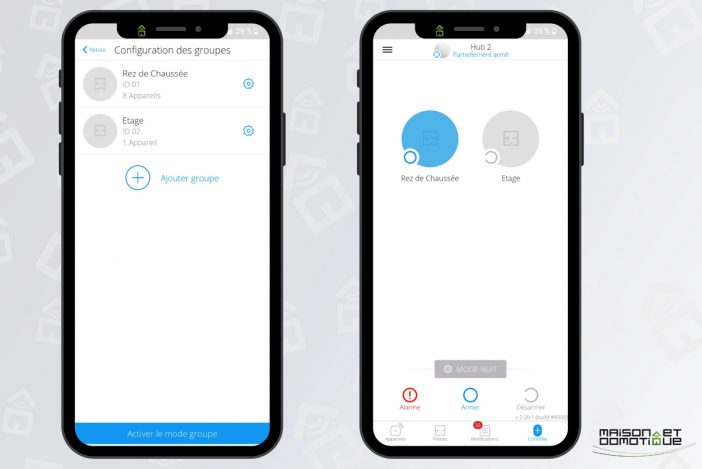
You can also perform a range test for detectors in the Ajax Hub parameters.
The parameters in the Jeweller section can be used to fine-tune the operation of the connection with the detectors. The “Ping interval” option is the sampling interval for the detectors. By default, it is configured for 36 seconds. This means that every 36 seconds, the Ajax hub contacts the detector to transfer and receive information: temperature sensor readings, battery charge, signal reception quality or safety mode activation/deactivation command. Increasing the interval will have a positive effect on battery life, but it will reduce the speed at which data about the device is updated in the application and the security mode is activated/deactivated. I've left it at default.
You can specify the “quantity of undelivered packages”, used to determine a device as lost. In this case, the system will send a notification to warn us. Here again, the default settings seem fine to me.
Now let's see how the Ajax alarm works in use…
Using the Ajax Hub 2 alarm
Setting up the Ajax alarm is really quick. In fact, most of the time is wasted in deciding where to place the sensors. After that, installing them using the double-sided tape or screws is a breeze. And configuration in the application is even quicker, thanks to QRCode scanning. No more complicated handling of the alarm and sensors, which we really appreciate!
The position of the Ajax Hub will be the most important: we generally try to position the control unit in the center of the home, to optimize communication with peripheral devices. But the range is so good on this system that it's not really a constraint: positioned in my patch cabinet, at one end of the house, all peripherals are perfectly covered even at 25m, some sensors being placed in the workshop at the bottom of the garden (i.e. 25m + at least two breeze-block walls to cross). All you need is a place with a power socket and an ethernet connection.
All that remains is to add the various sensors. Here, everything is even easier: the process of registering new sensors involves scanning the QR code on the device, switching on the sensor, assigning it to the corresponding room and entering the name to be displayed in the program. That's all there is to it. As the batteries are already in place on reception, all you have to do is activate the peripherals.
As for position, it's classic: an opening sensor on external openings, such as the front door or windows, for example. Motion detector in high-traffic areas, such as a corridor or landing. Just don't turn it towards a heat source or window. Once in place, of course, you'll need to test that it detects the way you want it to.
Like any alarm system worthy of the name, the Ajax alarm system is battery-powered. The peripherals are battery-powered anyway, so only the control unit is really affected by a power cut. Battery autonomy will depend on the number of devices connected, since the more devices there are, the more energy the control unit will consume to communicate with them. In my case, autonomy reached well over 10h, which is very respectable! Coupled with one or two Sim cards for communication, this alarm is ready for any power or phone line failure :)
The MotionCam's picture-taking function is a real plus for quickly checking what's going on: it's just a sequence of 3 to 5 images, but they give an overview of the action in progress (click to see the animation):

Finally, the system integrates a number of “home automation” commands. Among the available peripherals are the connected socket, a 220V micromodule, a relay and a wireless button. These various devices can be used to control lights, a gate, a valve to cut off the water supply, etc.
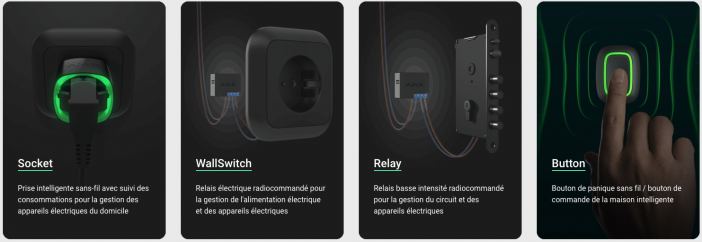
Installing one of these devices gives access to scenario functions, which can be triggered at a specific time, when the alarm is armed/disarmed, or on the alert of a particular device. You can, for example, switch on the connected socket at any time, whether the alarm is activated or not.

You could, for example, activate the socket when movement is detected outside. You could also switch on a lamp connected to the socket, a radio, etc., to trigger noise or movement visible from outside, as if someone were in the home.
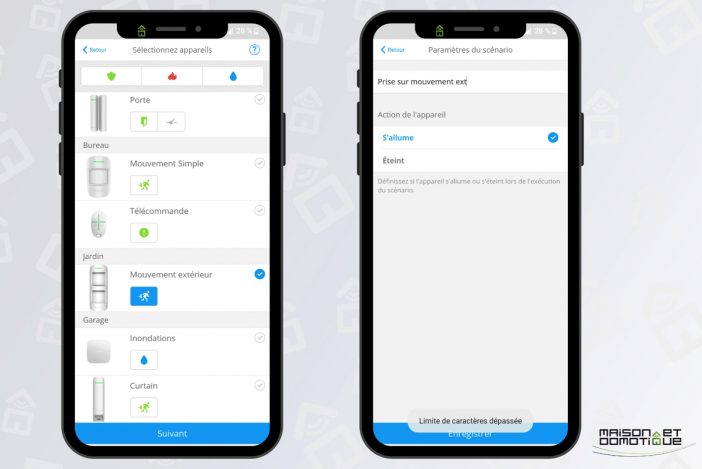
Numerous scenarios are possible: automatic switching off of appliances connected to the connected socket when you leave, to save energy; automatic switching on of lamps to simulate a presence; automatic switching off of water via a solenoid valve connected to the Ajax relay if a leak is detected, etc. The only regret: the system doesn't currently manage random times for effective presence simulation (e.g. random switching on of a lamp between 8pm and 11pm). Let's hope this function will be available soon, as it's only a software feature.
On the subject of functions to be developed, we'd also like to see temperature and power consumption monitored over time (by the connected socket). At present, this information can only be seen at the moment it is consulted (though with a cumulative total for the connected socket).
Ajax and external systems
Here we have a real alarm, worthy of professional equipment, and not a system for “geeks”. No compatibility with voice assistants, no IFTTT, etc., which could create so many security loopholes. The addition of sockets and relays already extends its capabilities a little. However, the Ajax system offers three other “openings”:
Firstly, the possibility of adding cameras from different manufacturers. It's always a good idea to be able to use one or more cameras to remotely clear up any suspicions, before having to bother anyone else to go to the scene. For this purpose, the system supports Dahua, Hikvision, Safire, Uniview and, more generally, RTSP cameras.
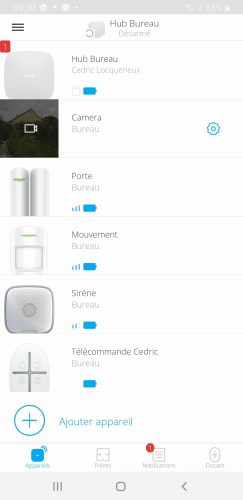
Camera-related functions are fairly light here, since they boil down to viewing the video stream, and taking pictures. But this at least has the advantage of being integrated into a single application, so there's no need to juggle in the event of an alert.
Another interesting feature is the ability to link the security system to a remote monitoring center, via the SIA protocol:

In addition to the possibility of calling up a monitoring center, which is sometimes very useful when you're on the other side of the world, for example, the SIA protocol is a standardized protocol for security systems. Last year, we saw that a Jeedom SIA plugin was available, largely designed to communicate with the Ajax alarm, which was very popular with users :) But this plugin essentially allowed you to receive information from the alarm. One-way communication.
But now, a plugin dedicated to Ajax is available in beta on the Jeedom market, built using the official API to which Jeedom has gained access (the final version should be available later this month if all goes well). This time, communication is a two-way process: Jeedom is able to receive all Ajax alarm information, such as sensor status, temperature, alarm mode, etc., which can then be used by other Jeedom applications. This data can then be used by Jeedom to create statistics or scenarios (such as switching the heating to eco mode when the total alarm is activated, for example). But it's also possible to control the alarm from Jeedom, to activate or deactivate it. And that's something that could be of interest to quite a few people, to have an alarm of this level of quality, compatible with Jeedom!
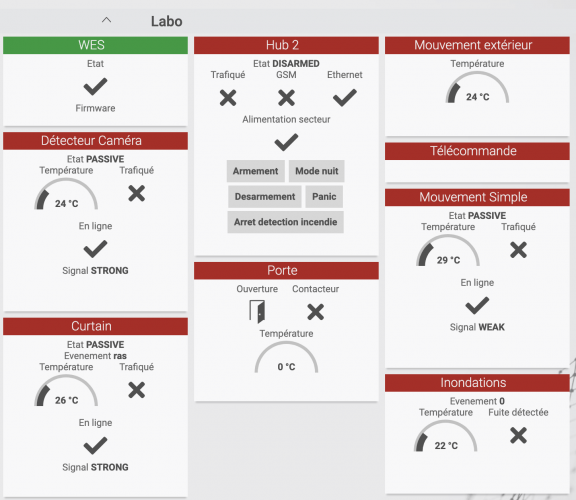
Conclusion
I spotted this security system at a security trade show a few years ago, and had heard a lot about it on the web, without having had the chance to test it for myself. After testing it last year, I understood better why it was so popular. And this second test with new peripherals only confirms this very good impression. This Ajax alarm system has all the hallmarks of a modern security system: the design, already a little “futuristic” yet discreet, a far cry from certain brands that are still very austere; the ease of installation, via an application and QRCode flashing; the security possibilities, thanks to the various peripherals available and communication with professional services.
In use for over a year now, I've noticed no false alarms or loss of communication, despite some sensors located in an annex building some twenty meters away (with 2 breeze-block walls in between).
The system offers everything you'd expect from an alarm system: zone management, 24/24 active peripherals, calendar, user management, battery, GSM backup, and much more, with access to some pretty advanced functions. It's without doubt the most complete system I've come across, while remaining very easy to install.
As mentioned above, my only regret is the absence of the ability to create scenarios with random schedules, to create a real presence simulation. And temperature and power consumption monitoring. But as I'm equipped with Jeedom for the home automation system, the release of an official Ajax plugin is excellent news, as these functions can be taken over by the home automation system, leaving the Ajax alarm to concentrate on its main use: security. I'll come back to the use of Jeedom as soon as the plugin is in stable release.
In terms of price, we're lower than many of the “big” brands. But what's more, you can take advantage of a 10% discount thanks to the code MAISON22 and our partnership with the ProtectHome store, which brings the Ajax Starter Kit pack down to 306€ instead of 340€! This applies to the whole store: Ajax alarms and accessories, as well as all other home security products. If you're looking for effective protection for your home, this is a system I can't recommend enough!

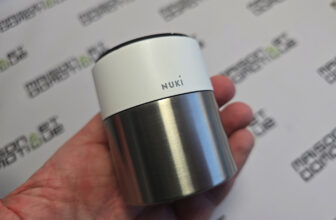
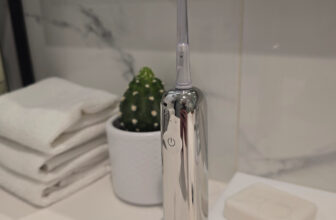



Please remain courteous: a hello and a thank you cost nothing! We're here to exchange ideas in a constructive way. Trolls will be deleted.